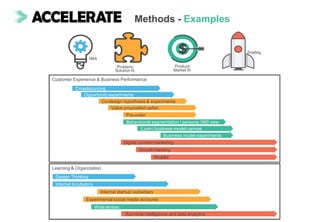Accelerate _methodologies
- 1. A validated methodology for acceleration Marko.Komssi@F-Secure.com Tiina.Apilo@vtt.fi Kaisa.Still@vtt.fi Justyna.Dabrowska@lut.fi
- 2. Acceleration Target Faster to the right markets To whom Companies targeting new business creation with customers What Drafting, creating, testing, validating How Experimentation, business modelling, utilizing social media, KPIs Inspiration Lean startup, business model creation, growth hacking, Word-of Mouth Marketing, design thinking Reality The need for financing and resources in acceleration activities
- 3. Idea Product/ Problem/ Scaling • High value concept • User acceptance • Resources to move forward • Money to create new business ideas • Channels, networks, brand • Validated and desired solution • Initial business model • Resources to move forward • Initial concept • Vision of new business • Committed people Growth discovery How to create fast growing and sustainable business? Customer discovery What is the problem that is worth solving? Solution discovery What is the solution that has real demand? Value proposition discovery How to acquire and retain the customers with a scalable business model? Solution fit Market fit Acceleration journey
- 4. 8 to-do’s for new business acceleration 1. Step outside of the building to recognize the real problems your potential customers are facing: e.g. apply user and customer experience thinking. 2. Make the whole acceleration journey with and for your users and customers. 3. Act fast but remember to invest time on eliciting material from the problem space, competitors and indirect competitors. There needs to be a well-argued problem statement. 4. Never stop with idea generation and small experimentations also with your business model. Continue it at every phase of your business. 5. Use the power of social media: e.g. in identifying problems, finding solutions, creating awareness and new markets. 6. Test and find social media channels suitable for you: utilise multiple supporting accounts and utilise platforms’ own analytics. 7. To guide your journey to scalable business, progressively select and use KPIs to track customer experience, business performance and learning. 8. Use acceleration tools & mindset and startup-like structures regardless of your company’s age and size.
- 5. Idea Product/ Problem/ Scaling Solution fit Market fit Drafted Created Tested Validated Problem Solution Value proposition Sustainable business Business model development during the acceleration process
- 6. Crowdsourcing Opportunity experiments Co-design hypothesis & experiments Internal startup/ subsidiary Customer Experience & Business Performance Learning & Organization Behavioural segmentation / persona /360 view (Lean) business model canvas Digital content marketing WoMM Run-time intelligence and data analytics Wide lenses Design Thinking Internal Incubatory Experimental social media accounts Value proposition safari Business model experiments Growth hacking Pre-order Idea Problem/ Solution fit Product/ Market fit Scaling Methods - Examples
- 7. Market size & Growth Potential market share Estimated costs Trend, partner, strategy, portfolio & ecosystem fits Strength & number of ”weak signals” # of unique visitors, engagement, bounce & conversion rates Success rate of proposals & Order Intake # of installs & average product review score Source of prospects Customer Experience & Business Performance Learning & Organization # of accelerated solutions by phase Renewals & Retention Revenue growth ARPU & Market share Referral & cross-sales rates NPS EBIT (Profit) # of business model experiments # of idea submissions % of potential new business ideas Idea Problem/ Solution fit Product/ Market fit Scaling KPI’s - Examples
- 8. Idea Stage Problem / Solution Fit Product / Market Fit Scaling Value Creation Value Capture Value Sustainability Description of the 4 phase model (© Sirris 2016) www.slideshare.net/omohout/genesis-43234459 www.slideshare.net/omohout/exodus-problem-solution 4 phase acceleration framework methodology description /masterclasses/ebooks









